 Website:
Fujifilm NDT Systems
Website:
Fujifilm NDT Systems
Group: Fujifilm
Catalog excerpts
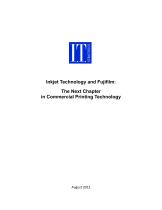
Inkjet Technology and Fujifilm: The Next Chapter in Commercial Printing Technology
Open the catalog to page 1
Inkjet Technology and Fujifilm: The Next Chapter in Commercial Printing Technology Inkjet technology has been used for more than 30 years in consumer inkjet printers. During the last five years big breakthroughs have occurred in scaling inkjet technology in terms of productivity and reliability. The advances have reached such a level that we are now at a stage where commercial printers and graphic arts services providers will soon no longer be able to thrive profitably without a digital printing component in their operations. With offset print job run lengths rapidly decreasing and the...
Open the catalog to page 2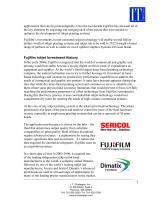
applications that can be printed digitally. Over the last decade Fujifilm has amassed all of the key elements by acquiring and merging each of the pieces that were needed to optimize the development of inkjet printing systems. Fujifilm’s investments in non-consumer inkjet technology will enable several billion dollars worth of inkjet printing systems and inkjet ink to be sold in 2012 through a broad range of partners as well as under its own Fujifilm Graphics Systems Division brand. Fujifilm Inkjet Investment History In the early 2000s, Fujifilm recognized that the world of commercial and...
Open the catalog to page 3
including several companies that many would perceive as direct competitors of Fujifilm. Similarly, this is true for Avecia and Sericol’s inks, now grouped under the name Fujifilm Imaging Colorants. With subsequent investments, Fujifilm cumulatively invested more than $1 billion dollars during the last six years in inkjet printing technology designed to serve graphic arts service providers and commercial printers. At the core of this investment has been print head technology. Print heads FUJIFILM Dimatix, Inc. – a leading provider of inkjet print heads to the graphics inkjet market,...
Open the catalog to page 4
Native resolution is a better indicator of print quality than apparent resolution, a statistic that is most often cited in the market place. SAMBA Print Head Technical Capabilities Nozzles/head Native resolution (dpi) Droplet size Firing frequency Footprint of single head Print bar configurations Compatible Ink types Ink viscosity range 2,048 1,200 0.1 to 2 picoliter variable, up to 100 Khz < 2" deep 3.2” to 72”+; limited by data processing ability aqueous, solvent, UV-curable, oil, other 5-10 centipoise MEMS technology, an abbreviation for microelectromechanical systems, relies on silicon...
Open the catalog to page 5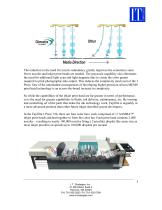
The reduction in the need for nozzle redundancy greatly improves the economics since fewer nozzles and inkjet print heads are needed. The grayscale capability also eliminates the need for additional light cyan and light magenta inks to create the color gamut required to print photographic-like output. This reduces the complexity (and cost) of the J Press. One of the unintended consequences of developing higher precision silicon MEMS print head technology is an across-the-board increase in complexity. So while the capabilities of the inkjet print head are far greater in terms of performance,...
Open the catalog to page 6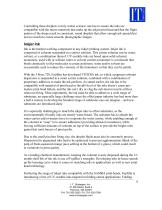
Controlling these droplets is truly rocket science: one has to ensure the inks are compatible with the micro-materials that make up the inkjet print head and that the flight pattern of the drops result in consistent, round droplets that allow enough ink spread (but not too much) to create smooth, photographic images. Inkjet Ink Ink is the hardest working component in any inkjet printing system. Inkjet ink is composed of colorant suspended in a carrier solution. This carrier solution can be water, solvent, or a combination thereof. UV-curable inks are based upon solid colorant monomers, used...
Open the catalog to page 7
cartons are subject to more “abuse” than document print applications, in that they are finished into three-dimensional structures where the ink has to stretch around corners and must adhere even more strongly than water-based inks due to abrasion that occurs during the shipping process when the folding cartons rub against the secondary corrugated shipping containers (corrugated material is quite abrasive, much like sandpaper) and other material. Fujifilm’s background in offset plate technology is extremely helpful in understanding the application requirements for each ink type that is being...
Open the catalog to page 8
Application Experience Fujifilm’s inkjet technology reaches across a broad Fujifilm Acuity LED 1600 large format printer range of applications. While the J Press 720 may garner the most attention among commercial and graphic arts printers, Fujifilm also has a strong background in large format printing systems. The very latest Fujifilm Acuity large format printer features yet another breakthrough: LED UV-curing lamps. The Acuity LED 1600 features LED UVink curing lamps that use much less energy than traditional ARC-type lamps, which, aside from lower energy costs, also provide the additional...
Open the catalog to page 9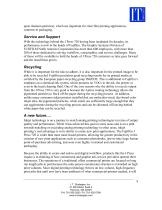
upon titanium particles), which are important for clear film printing applications, common in packaging. Service and Support With the technology behind the J Press 720 having been incubated for decades, its performance is now in the hands of Fujifilm. The Graphic Systems Division of FUJIFILM North America Corporation has more than 600 employees, with more than 200 of those dedicated to solving workflow, consumables, and service challenges. Many of those will be available to hold the hands of J Press 720 customers as time goes forward and the install base grows. Recycling While it is...
Open the catalog to page 10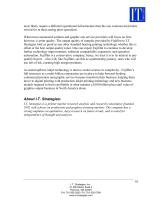
most likely require a different operational infrastructure than the one commercial printers strived for in their analog print operations. What most commercial printers and graphic arts service providers will focus on first, however, is print quality. The output quality of samples provided by Fujifilm to I.T. Strategies look as good as any other standard bearing printing technology whether this is offset or the best output quality toner. One can expect Fujifilm to continue to develop further technology improvements, substrate compatibility expansion, and operation automation. Fujifilm is a...
Open the catalog to page 11All Fujifilm NDT Systems catalogs and technical brochures
-
J Press FP790
2 Pages
-
Polaris PQ-512/15 AAA
2 Pages
-
Inca SpyderX
8 Pages
-
LT8
2 Pages
-
FUJINON Machine Vision Lens
10 Pages
-
Inca OnsetM
2 Pages
-
3592
1 Pages
-
LTO Ultrium 9
2 Pages
-
DRY MINILAB Frontier DX100
2 Pages
-
DRY MINILAB Frontier DL 600
2 Pages
-
DRY MINILAB Frontier DL650
2 Pages
-
XQ2
3 Pages
-
X-E2S
8 Pages
-
X-A3
4 Pages
-
X-A10
2 Pages
-
x100t
8 Pages
-
X30
8 Pages
-
GFX 50S
18 Pages
-
Frontier solution
4 Pages
-
Frontier DL600
2 Pages
-
Graphium UV Digital Press
8 Pages
-
instax WIDE 300
2 Pages
-
x mount lenses
15 Pages
-
J Press 540W
8 Pages
-
DL650 PRO Dry Minilab
2 Pages
-
Frontier LP5700R
2 Pages
-
Frontier-S DX100 Brochure
2 Pages
-
J Press 720S
20 Pages
-
X-Pro 1
4 Pages
-
Buffered Oxide Etchants
1 Pages
-
Super DLTtape II
2 Pages
-
LTO Ultrium 6
2 Pages
-
FUJINON-FA-MV-CCTV-LENS
13 Pages
-
DynamIX? ImageShare
2 Pages
-
Prescale Brochure
4 Pages
-
DynamIX HR
1 Pages












































